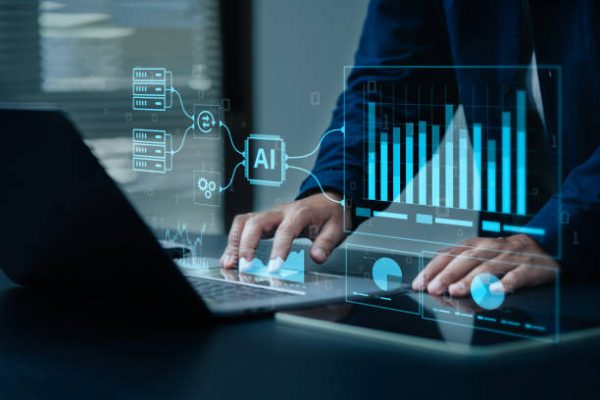
- March 22 2025
- SFI Solution Team
The Role of AI in Predictive Integration and Automation
In the current fast-paced digital environment, companies are progressively turning to Artificial Intelligence (AI) to improve predictive integration and automation. AI-powered predictive analytics is revolutionizing various sectors by facilitating real-time decision-making, enhancing operational efficiency, and lowering expenses. This blog examines the significance of AI in predictive integration and automation, along with its advantages, challenges, and emerging trends.
Understanding Predictive Integration and Automation
Predictive integration refers to the use of AI and machine learning (ML) to anticipate future trends, automate data processes, and enhance system interoperability. Automation, on the other hand, involves using AI-driven tools to streamline repetitive tasks, optimize workflows, and improve accuracy.
AI-powered predictive integration allows businesses to process large volumes of data, detect patterns, and forecast future outcomes. By integrating AI with automation, organizations can create self-learning systems that continuously improve efficiency and performance.
The Role of AI in Predictive Integration
-
Data Analysis and Processing
AI-driven predictive integration enables organizations to analyze massive datasets quickly and accurately. Machine learning algorithms can identify trends, anomalies, and correlations within data, leading to smarter decision-making. -
Real-time Predictive Insights
AI facilitates real-time monitoring and forecasting by leveraging historical data and advanced analytics. This capability allows businesses to make proactive decisions, reducing downtime and enhancing operational efficiency. -
Enhanced System Interoperability
AI-powered integration solutions improve the compatibility between different enterprise systems, databases, and applications. This ensures seamless data flow and better synchronization between departments. -
Automated Decision-Making
By utilizing AI, organizations can automate decision-making processes based on predictive insights. AI algorithms can assess risk factors, optimize supply chains, and recommend best courses of action without human intervention. -
Error Reduction and Compliance
AI-driven automation helps minimize human errors and ensures compliance with industry regulations. Predictive analytics can flag inconsistencies and potential risks, allowing companies to address issues before they escalate.
Benefits of AI in Predictive Integration and Automation
-
Improved Efficiency : AI optimizes workflows and reduces manual intervention, leading to faster and more efficient processes.
-
Cost Reduction : Automating repetitive tasks reduces labor costs and minimizes errors, saving businesses money.
-
Better Customer Experience : AI-driven insights help personalize customer interactions, improving satisfaction and loyalty.
-
Scalability : AI-powered automation solutions can scale with business needs, accommodating growing data volumes and complex integrations.
-
Risk Mitigation : Predictive analytics allow organizations to foresee potential risks and take proactive measures to prevent disruptions.
Challenges of AI in Predictive Integration and Automation
-
Data Quality and Availability : AI relies on high-quality data for accurate predictions. Incomplete or inaccurate data can lead to unreliable insights.
-
Implementation Costs : Initial investment in AI-powered tools and infrastructure can be high, deterring small businesses.
-
Security Concerns : AI-driven automation systems require robust cybersecurity measures to prevent data breaches and cyber threats.
-
Resistance to Change : Employees may be hesitant to adopt AI-based automation due to job security concerns.
Future Trends in AI-Driven Predictive Integration
-
Hyperautomation : Businesses will increasingly adopt AI-driven hyperautomation to optimize end-to-end processes.
-
AI and IoT Integration : AI-powered predictive analytics will be integrated with IoT devices for enhanced real-time monitoring.
-
Explainable AI (XAI) : The demand for transparent AI decision-making processes will rise to improve trust and compliance.
-
Edge AI for Faster Processing : AI algorithms will be deployed on edge devices for quicker data processing and real-time insights.
-
Self-Learning AI Models : Future AI-driven automation systems will evolve through continuous learning, improving their accuracy over time.
Conclusion
AI-driven predictive integration and automation are revolutionizing industries by enhancing efficiency, reducing costs, and improving decision-making processes. While challenges exist, advancements in AI technology are paving the way for more sophisticated and scalable solutions. Businesses that embrace AI-powered predictive integration will gain a competitive edge in today’s digital economy.
By leveraging AI-driven automation, organizations can future-proof their operations and unlock new growth opportunities. As AI continues to evolve, its role in predictive integration and automation will become even more crucial in shaping the business landscape.
Previous Post